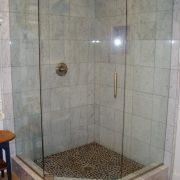Removing black mold on the shower walls
Black mold usually develops on the walls of the shower, using soap film as source of food. This type of black mold is not usually one of the most deadly black molds, but still needs to be removed as soon as possible because it may contain a species of mold that cause allergy problems and asthma for members of the household susceptible to breathing problems. Removing the black mold on the shower walls is a two-step process, in which you kill mold, then remove the discoloration of black mold.
Instructions
- Squeeze the liquid detergent directly on a wet sponge and wash the moldy section of the shower wall to remove soap film and dirt. Do not use commercial cleaners to clean the area, since you’ll be using bleach later and don’t want to risk a chemical reaction.
- Rinse the section well with cold water and dry with a cloth or an old towel.
- Pour 1/4 cup of bleach in a one quart (1.14 L) spray bottle. Fill the rest of the bottle with cold water.
- Shake the bottle to mix the contents and then spray the moldy section with the mixture. Allow the mixture to sit for ten minutes.
- Rinse the wall with cold to remove the bleach. Make sure the wall is completely clean, with no bleach residue.
- Put a small amount of strong detergent, such as laundry detergent; rub on a pad or brush. Choose an tool that is suitable for cleaning the surface of the shower that will not scratch the finish.
- Rinse mold section with hot water, then rub with brush or pad until you have removed the stains.
- Rinse the area thoroughly with warm water. Be sure to remove the detergent.
Tips & Warnings
- If the shower walls develop rust regularly, consider cleaning the shower more often to remove the soap film.
- Wear gloves and a mask when working with chemical cleaners, especially bleach.
- Ventilate the bathroom as much as possible when working with bleach.






